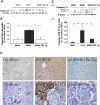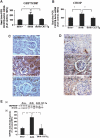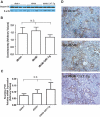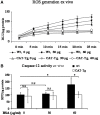Reactive oxygen species promote caspase-12 expression and tubular apoptosis in diabetic nephropathy
- PMID: 20299359
- PMCID: PMC2900966
- DOI: 10.1681/ASN.2009030242
Reactive oxygen species promote caspase-12 expression and tubular apoptosis in diabetic nephropathy
Abstract
Apoptosis of tubular epithelial cells contributes to the tubular atrophy that accompanies diabetic nephropathy. Reactive oxygen species (ROS) promote tubular apoptosis, but the mechanisms by which this occurs are incompletely understood. Here, we sought proapoptotic genes that ROS differentially upregulate in renal proximal tubular cells of diabetic (db/db) mice. We performed microarray analysis using total RNA from freshly isolated renal proximal tubules of nondiabetic, diabetic, and diabetic transgenic mice overexpressing catalase in the proximal tubule (thereby attenuating ROS). We observed greater expression of caspase-12 in the proximal tubules of the diabetic mice compared with the nondiabetic and diabetic transgenic mice. Quantitative PCR and immunohistochemistry confirmed the enhanced expression of caspase-12, as well as members of the endoplasmic reticulum stress-induced apoptotic pathway. Ex vivo, albumin induced caspase-12 activity and expression (protein and mRNA) and mRNA expression of the CCAT/enhancer-binding protein homologous protein in freshly isolated wild-type proximal tubules but not in catalase-overexpressing proximal tubules. In vitro, albumin stimulated activity of both caspase-12 and caspase-3 as well as expression of caspase-12 and CCAT/enhancer-binding protein homologous protein in a human proximal tubule cell line (HK-2). The free radical scavenger tiron inhibited these effects. Furthermore, knockdown of caspase-12 with small interfering RNA reduced albumin-induced apoptosis in HK-2 cells. Taken together, these studies demonstrate that albuminuria may induce tubular apoptosis through generation of ROS and the subsequent expression and activation of endoplasmic reticulum stress genes in the diabetic kidney.
Figures










Comment in
-
Caspase-12 and diabetic nephropathy: from mice to men?J Am Soc Nephrol. 2010 Jun;21(6):886-8. doi: 10.1681/ASN.2010040394. Epub 2010 May 6. J Am Soc Nephrol. 2010. PMID: 20448021 No abstract available.
Similar articles
-
Caspase-12 and diabetic nephropathy: from mice to men?J Am Soc Nephrol. 2010 Jun;21(6):886-8. doi: 10.1681/ASN.2010040394. Epub 2010 May 6. J Am Soc Nephrol. 2010. PMID: 20448021 No abstract available.
-
Cannabinoid receptor 1 mediates palmitic acid-induced apoptosis via endoplasmic reticulum stress in human renal proximal tubular cells.J Cell Physiol. 2010 Nov;225(3):654-63. doi: 10.1002/jcp.22255. J Cell Physiol. 2010. PMID: 20506110
-
Attenuation of interstitial fibrosis and tubular apoptosis in db/db transgenic mice overexpressing catalase in renal proximal tubular cells.Diabetes. 2008 Feb;57(2):451-9. doi: 10.2337/db07-0013. Epub 2007 Oct 31. Diabetes. 2008. PMID: 17977949
-
New developments concerning the proximal tubule in diabetic nephropathy: in vitro models and mechanisms.Nephrol Dial Transplant. 2015 Aug;30 Suppl 4:iv60-7. doi: 10.1093/ndt/gfv264. Nephrol Dial Transplant. 2015. PMID: 26209740 Review.
-
The proximal tubule in the pathophysiology of the diabetic kidney.Am J Physiol Regul Integr Comp Physiol. 2011 May;300(5):R1009-22. doi: 10.1152/ajpregu.00809.2010. Epub 2011 Jan 12. Am J Physiol Regul Integr Comp Physiol. 2011. PMID: 21228342 Free PMC article. Review.
Cited by
-
Pemt deficiency ameliorates endoplasmic reticulum stress in diabetic nephropathy.PLoS One. 2014 Mar 25;9(3):e92647. doi: 10.1371/journal.pone.0092647. eCollection 2014. PLoS One. 2014. PMID: 24667182 Free PMC article.
-
Caspase 12 degrades IκBα protein and enhances MMP-9 expression in human nasopharyngeal carcinoma cell invasion.Oncotarget. 2017 May 16;8(20):33515-33526. doi: 10.18632/oncotarget.16535. Oncotarget. 2017. PMID: 28380444 Free PMC article.
-
A novel role of peroxiredoxin 2 in diabetic kidney disease progression by activating the classically activated macrophages.Sci Rep. 2024 Nov 16;14(1):28258. doi: 10.1038/s41598-024-79678-4. Sci Rep. 2024. PMID: 39550424 Free PMC article.
-
Heat shock protein 70 and albuminuria in patients with type 2 diabetes: a matched case control study.Cell Stress Chaperones. 2013 Nov;18(6):815-9. doi: 10.1007/s12192-013-0435-x. Epub 2013 May 17. Cell Stress Chaperones. 2013. PMID: 23681922 Free PMC article.
-
Liraglutide protects against high-fat diet-induced kidney injury by ameliorating apoptosis.Endocr Connect. 2020 Oct;9(9):946-954. doi: 10.1530/EC-20-0294. Endocr Connect. 2020. PMID: 33027757 Free PMC article.
References
-
- Rabkin R: Diabetic nephropathy. Clin Cornerstone 5: 1–11, 2003. - PubMed
-
- Sarafidis PA, Stafylas PC, Kanaki AI, Lasaridis AN: Effects of renin-angiotensin system blockers on renal outcomes and all-cause mortality in patients with diabetic nephropathy: An updated meta-analysis. Am J Hypertens 21: 922–929, 2008. - PubMed
-
- Gordois A, Scuffham P, Shearer A, Oglesby A: The health care costs of diabetic nephropathy in the United States and the United Kingdom. J Diabetes Complications 18: 18–26, 2004. - PubMed
-
- Hovind P, Tarnow L, Parving HH: Remission and regression of diabetic nephropathy. Curr Hypertens Rep 6: 377–382, 2004. - PubMed
-
- Tarchini R, Bottini E, Botti P, Marseglia CD, Talassi E, Baraldi O, Lambertini D, Gaetti L, Bellomi A: Type 2 diabetic nephropathy: Clinical course and prevention proposals 2004 [in Italian]. G Ital Nefrol 22[Suppl 31]: S15–S19, 2005. - PubMed
Publication types
MeSH terms
Substances
Grants and funding
LinkOut - more resources
Full Text Sources
Other Literature Sources
Medical
Molecular Biology Databases
Research Materials
Miscellaneous

